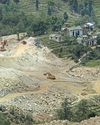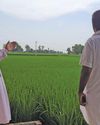The pattern of burning crop residue in India is changing. The practice is no longer limited to the post-monsoon crop of rice or the northern states of Punjab and Haryana
JITENDRA, SHREESHAN VENKATESH, ISHAN KUKRETI, KUNDAN PANDEY, DEEPANWITA NIYOGI and POLASH MUKERJEE travel to five states across the country to study the trend.

ON APRIL 20, there was a piece of good news for residents of Delhi from the sky, literally. A satellite image released by the American space agency, NASA, showed that incidents of crop residue burning in Delhi’s neighbouring states of Punjab and Haryana had significantly reduced compared to last year. But the joy was short-lived as subsequent images showed a spike in crop residue burning from the two states.
A year ago, when the Delhi government implemented the second edition of the odd-even vehicle restriction during April 15-30 to fight air pollution, the Central Pollution Control Board, to everyone’s surprise, found that the pollution levels had increased during the experiment. This put a question mark on the efficacy of the emergency measure. Clean air campaigners and members of the Environment Pollution (Prevention & Control) Authority (EPCA), a body appointed on the Supreme Court’s directive to oversee environmental issues in the National Capital Region, went through volumes of data to understand this paradox. That answer came from an image sent by a NASA satellite. The image showed that the smoke from crop residue burning in Punjab and Haryana had travelled to the national capital, causing the rise in air pollution.
“But farmers don’t burn the rabi wheat crop residue, because it is an important fodder. We knew then that there was widespread burning post-paddy harvest—from October end till mid-November each year. This was happening because farmers in Punjab and Haryana were caught in a vicious time cycle—they had to harvest rice and cultivate wheat in a space of 10-15 days. Rice straw was not a useful fodder, but we did not know about the burning of wheat residue,” explains Bhure Lal, former bureaucrat and now chairperson of EPCA. What then is happening? Why are farmers burning valuable fodder? Is this only about Punjab and Haryana? No.
Diese Geschichte stammt aus der May 16, 2017-Ausgabe von Down To Earth.
Starten Sie Ihre 7-tägige kostenlose Testversion von Magzter GOLD, um auf Tausende kuratierte Premium-Storys sowie über 8.000 Zeitschriften und Zeitungen zuzugreifen.
Bereits Abonnent ? Anmelden
Diese Geschichte stammt aus der May 16, 2017-Ausgabe von Down To Earth.
Starten Sie Ihre 7-tägige kostenlose Testversion von Magzter GOLD, um auf Tausende kuratierte Premium-Storys sowie über 8.000 Zeitschriften und Zeitungen zuzugreifen.
Bereits Abonnent? Anmelden

A SPRIG TO CARE FOR
Punarnava, a perennial herb, is easy to grow and has huge health benefits

DIGGING A DISASTER
Soapstone mining near Dabti Vijaypur village has caused many residents to migrate.

REVIEW THE TREATMENT
Several faecal sludge treatment plants in Uttar Pradesh suffer from design flaws that make the treatment process both expensive and inefficient

MAKE STEEL SUSTAINABLE
As India works to double its GDP by 2030, its steel industry must balance growth with sustainability. By embracing policies like the Steel Scrap Recycling Policy 2019 and adopting green technologies, India is paving the way for a more sustainable future in steel production

Can ANRF pull off the impossible for India?
Anusandhan National Research Foundation is expected to reorient India's innovation goals but funding issues, old mindsets remain a drag

TROUBLED WOODS
Forests are a great bulwark against climate change. But this is fast changing. AKSHIT SANGOMLA travels through some of the pristine patches of the Western Ghats to explore how natural disturbances triggered by global warming now threaten the forest health

BLINDING GLOW
The science is clear: increased illumination has damaging consequences for the health of humans, animals and plants. It’s time governments introduced policies to protect the natural darkness and improved the quality of outdoor lighting.

GROUND REALITY
What happens when the soil loses the ability to grow healthy, high-yield crops on its own?

GM POLICY MUST BE FARMER CENTRIC
On July 23, the Supreme Court of India directed the Union government to develop a national policy on genetically modified (GM) crops for research, cultivation, trade and commerce through public consultation.

Vinchurni's Gandhi
A 96-year-old farmer transforms barren land into a thriving forest in drought-prone region of Satara